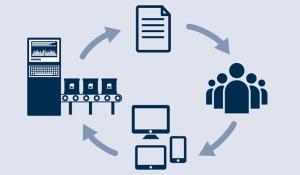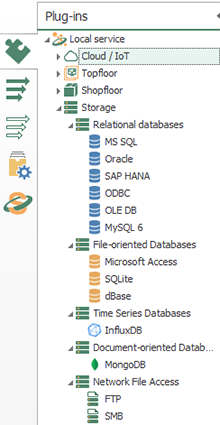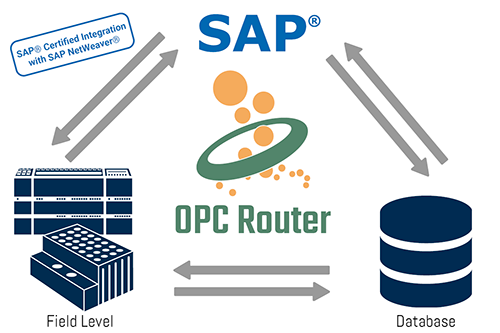For various reasons, many organizations still have one or more disconnects between the PLCs and other control devices closest to the ultimate process and the upstream systems responsible for coordinating efforts across the enterprise. In an ideal world, all data exchange between all systems in an enterprise would be automated for the greatest efficiency.
In this post (based on the article "Removing five critical media gaps" by our partner company, inray Industriesoftware GmbH), we will discuss five of the most common gaps where an organization's ERP system may still be disconnected from underlying processes and data sources. And we'll discuss how OPC Router provides the ability to eliminate those unnecessary gaps.
A key focus of Industry 4.0 is closing all connectivity gaps in manufacturing and other industries.

Such gaps are a contributing factor to why present-day manufacturing potential cannot be utilized fully. Five areas in production are particularly affected: these areas slow down production processes, and increase both error rates and workload.
- Manual Record-Keeping of Process Values
- Key Production Data Is Isolated in a Spreadsheet (or other "islands")
- Paper Data Requiring Manual Entry
- Manual Entry of ERP Data into Labeling and Other Systems
- Manual Transfer of Process Parameters to PLCs and Other Control Systems from ERP
There are numerous benefits to closing those five digital communication gaps (which we'll discuss in more detail shortly). The advantages of interconnected information technology (IT) and of digitally cross-linked operations technologies (OT) can be utilized in the best possible way. Networked production doesn't always need to be difficult, if production entities make use of one common communication standard, which joins all systems, machines and devices seamlessly together for cross-platform communication.
1. Manual Record-Keeping of Process Values
If a production environment isn’t fully digitally integrated, this essentially implies that production lines and spaces aren’t seamlessly interconnected with a company’s entire architecture of miscellaneous systems. The greatest downside in that case is that important process values and other results (i.e. actual machine data) are not readily accessible across all production levels (that data is locked up in those respective machines or systems).
In production facilities, a variety of machinery has been implemented insular solutions in this fashion. Although the machines operate well throughout the production process, in accordance with their respective technical characteristics, the machine’s record-related data activity cannot be accessed via an external interface. As a result, that data cannot be made available in a seamless dataflow to be considered along with similar data from other systems across the plant.
 As such, important process values and results must be manually read out (i.e. written down by hand) and then manually entered into another system. A human has to literally transfer the data off the machine display into a list by jotting everything down on a sheet of paper or entering it into a spreadsheet, to produce that needed record of the machine’s data activities. This method, while less common that it was 10 or 20 years ago, is still an unfortunate reality in many production environments and causes error-prone operating processes. Workflows aren’t smooth but rugged. Writing errors during transcription occur regularly.
As such, important process values and results must be manually read out (i.e. written down by hand) and then manually entered into another system. A human has to literally transfer the data off the machine display into a list by jotting everything down on a sheet of paper or entering it into a spreadsheet, to produce that needed record of the machine’s data activities. This method, while less common that it was 10 or 20 years ago, is still an unfortunate reality in many production environments and causes error-prone operating processes. Workflows aren’t smooth but rugged. Writing errors during transcription occur regularly.
Now consider the difference when that gap is eliminated and access directly to the machine and its data is possible from the other systems in your organization. Machine and production data is much more reliable since potential human error and latency has been minimized. Production-related process values and results reliably reach their desired destinations in their respective target systems because networked data transfer warrants error-free transmissions; as long as connectivity architectures have been implemented correctly, to prevent data redundancy.
Centralized access to solid information empowers both staff members and managers to continually keep pace with production units and to make decisions based on facts rather than estimates. Important process values and other needed data can be attained in a timely manner, which allows interference with production processes just in time, minimizing negative results. Networked data flow ensures information transfer about error messages and fault reports – for instance about energy consumption and production times – much closer to real time so more responsive action can be taken, where warranted.
Through Industry 4.0 interoperability, process values and results can be networked and managed centrally – the proliferation of OPC technology (both in the form of OPC UA and OPC Classic) continues to facilitate greater and greater connectivity, along with other connectivity standards such as MQTT. Having such standards readily available provides the means to transfer your critical production data quickly, reliably and fault-free – for connectivity to PLCs and other systems.
Making this process easier is the ability to cross-link your process machines with the OPC UA plug-in for OPC Router for reliable interoperability between your machines and other systems with full access to automation components.
2. Key Production Data Is Isolated in a Spreadsheet (or other "islands")
If machine data is processed and/or analyzed in Microsoft Excel spreadsheets, Excel is being used as stopgap “database” of sorts, and a makeshift solution for this gap in production data accessibility. While we see less of this gap these days, there are still organizations that rely heavily on spreadsheets for such functionality.
While Excel is versatile and useful in the business world, it is an isolated tool for integrating process data across an enterprise. It can never produce the diversity of applications and quality of performance a good database can provide. As a result, process data sitting in an Excel spreadsheet is not Industry 4.0-compatible, as the information they contain is not readily accessible within an otherwise Industry 4.0-ready environment.
Excel spreadsheets are only partially helpful for processing information, as they do not measure up against state-of-the-art information management and are not well-suited for dissemination of information across an organization. Carrying out data maintenance tasks is hard to do in a reliable way in Excel, too. Mainly because it wasn’t designed to be used as database in the first place and does not offer Industry 4.0-compatibility in and of itself.
It is also not possible to connect reliably connect Excel to IoT and other systems without suitable middleware. Even though it is possible to make use of Excel in multiple ways, it does not provide the needed efficiency when compared to dynamic data management.
 Again, let's consider the difference when the same data previously stored in an Excel spreadsheet is, instead, accessible to upstream HMI, SCADA and ERP systems directly and stored in an intermediate database for historization, trending and reporting applications. Process data can be sent to a database directly, if the appropriate data protocol is used for data transfers and if a powerful middleware ensures that transactions can be carried out on a 24/7 basis.
Again, let's consider the difference when the same data previously stored in an Excel spreadsheet is, instead, accessible to upstream HMI, SCADA and ERP systems directly and stored in an intermediate database for historization, trending and reporting applications. Process data can be sent to a database directly, if the appropriate data protocol is used for data transfers and if a powerful middleware ensures that transactions can be carried out on a 24/7 basis.
Databases like MySQL, Oracle and ODBC provide many possibilities for data storage. If all machines and equipment in an enterprise are connected with databases and upstream systems, the data can be fully utilized because all the available data becomes accessible and can be used together for better decision making.
And in those situations where there is still a need in the organization for Excel spreadsheets for dealing with administrative subtasks, the required data can now be generated from the database, eliminating manual copying work at the machine. Handwritten lists now don’t have to be transferred into Excel and don’t have to be kept up-to-date by human effort.
Through Industry 4.0 interoperability machine and production data can be managed fast and profoundly. Your machine data becomes quickly available in your database – with the OPC Router provided by inray.
And with its connectivity options across disparate systems, OPC Router makes it possible to send your process data directly to your database; for instance to MySQL, ODBC, Oracle, but also to Codebase or SQLite. And with the aforementioned OPC UA interface, your systems are ready for OPC UA Data Access Automation.
3. Paper Data Requiring Manual Entry
Wherever handwritten notes are relied on as a primary data collection mechanism, chaos is normally on the menu. It's incredibly inefficient to still be entering data manually into an ERP system. There was a time where it was necessary - that time has long passed. There are multiple downsides to this practice, not the least of which are time-consuming human effort and the potentially for errors as a result of that human effort.
Alternately, that same process data could be easily sent to your ERP system via appropriate middleware. Manual logs can easily get lost between production and administration (or even destroyed). The data contained in paper documents might not be correct - if the human taking the readings misinterpreted those readings or has illegible handwriting, the actual results could be way off. As such, entering those results into your ERP system could result in dirty data, causing you to make decisions on erroneous information.
This particular gap between manufacturing and administration, where the managers of various business units and production lines have their offices, is quite sensitive. This is due to the fact that staff members who are not working directly in a company’s plant floor can't easily monitor work processes in production and cannot examine them throughout running procedures either. They always have to pick up the phone or write emails or walk over to the facilities in order to stay informed about what’s actually happening in production.
As a result, decisions based on that data are slowed down either due to the mechanism or due to problems in production being either noticed or reported much too late to production line managers. If this gap isn’t closed, actually determining optimization possibilities early on and implementing them in a timely manner won’t be possible either. Sometimes optimization opportunities remain completely unidentified.
Once that paper chase is eliminated, machine and manufacturing data as well as diverse alerts or notices, which are important for maintaining productivity as well as for quality assurance, find their way into the in near real-time to the ERP system. In many cases, a company’s data network is comprised of many subnets that should be able to communicate with each other to offer seamless Industry 4.0-capabilities. When SAP acts as main management platform, which is connected with all your company’s subnets, this results in well-arranged data management and rids you of “paper data” once and for all.
Ideally, process data and information flows into the ERP system from all data sources available in the enterprise and can be retrieved from everywhere, too. If your company is put in that fortunate position, you have reached your goal to implement end-to-end data management (E2E) in your company. Now all data that is produced in your company can be made use of in a holistic and agile manner. The OPC Router ensures that this works not just in theory but in practice.

Data is accessible just-in-time, and can be verified and validated in an enterprise-wide network during running procedures. Moreover, approval processes can be defined to reduce risks to an absolute minimum. Database data delivery makes use of preprocessed data. Data storage in databases is possible for orders and recipes. The SAP plug-in for OPC Router, coupled with a variety of plug-ins for other systems including OPC UA, can bring that ideal scenario closer to reality.
4. Manual Entry of ERP Data into Labeling and Other Systems
 When labelers or labeling systems are not able to retrieve any or all needed information from the ERP system, labeling becomes a risky business. This risk occurs at an important intersection of the company. As a result, data being used to generate those labels might well be full of errors. It takes additional effort to verify the correctness of the data, as one can never be quite certain if the data is totally faultless and thus can be relied upon fully.
When labelers or labeling systems are not able to retrieve any or all needed information from the ERP system, labeling becomes a risky business. This risk occurs at an important intersection of the company. As a result, data being used to generate those labels might well be full of errors. It takes additional effort to verify the correctness of the data, as one can never be quite certain if the data is totally faultless and thus can be relied upon fully.
It's not uncommon for such data to be stored in several different systems. The problem with this is that if these respective systems are not interconnected via an enterprise-wide information platform – or cannot be stored as specified data telegrams – they cannot be checked for errors holistically (i.e. checking all data together in one place). More time is needed to verify the correctness of data involving various departments, as the needed data is derived from data sources from customer service, order handling, production and dispatch. Only when all needed data is put together can the printing of labels or the printing directly on packaging material via respective labelers or printing systems occur. Printing/labeling goods or packages ready for delivery with incorrect data will almost certainly lead to higher overhead costs and expensive rejects and/or rework.
However, directly connecting labeling systems to a designated SAP ERP system results in the required data being instantly available at the labeler or labeling systems. Provided that a productive middleware establishes the required connection, such data can be sent as data telegrams to the printer, labeler or printing unit.
In all practicality, this means that the required production data is sent to already defined data fields at the addressed printer and directly into the respective stored layout for correct printing of predefined printing formats. Examples of the sort of important data needed for printing labels are item and lot numbers, quantities, MHD and batch numbers, as well as SSCC barcodes.
The Serial Shipping Container Code (SSCC) is an 18-digit number, mostly also represented as barcode, used to identify logistics units, which helps identify shipment items correctly and to also track them all the way through from respective dispatch locations to target destinations. A lot of information is needed to label products in compliance with rules and regulations and to ensure that goods are accurately sent to the right recipient.
Through Industry 4.0 interoperability, labelers and printers can be integrated into an existing Industry 4.0 infrastructure. With this architecture, your SAP data can be sent in the right data format to the printer and then printed on the correct label in the correct format – via the OPC Router and its plug-ins for a variety of printers and labelers including Zebra, Domino, Wolke, MS Windows and generic TCP printers.
5. Manual Transfer of Process Parameters to Control Systems from ERP
In an automated production environment, connectivity or integration gaps requiring PCR parameterization by hand (e.g. for recipes and order information) are especially problematic given their location at the heart of highly automated production plants.
Does anyone ever really want to adjust parameter settings manually? The short answer, NO! Work processes are slow and drag along because parameterization takes a lot of time, especially if human interaction is required for every single change notice that makes parameter changes necessary. It’s incredibly inefficient to go about your production business in such a fashion, as machines developed around the turn of the millennium are equipped with CNC or PLC technology and are waiting to be interconnected with an intelligent communication network.
As such, in operations where this is still the norm, it should be a primary focus to eliminate manual parameterization in favor of establishing direct connections to ERP/MES and PLCs. The ERP system sends parameters and other adjustment data directly to the machine’s PLCs.
Automated PLC parameterization is well within reach through the OPC Router and its plug-ins for SAP, OPC and other standard interfaces. The machine can be parameterized automatically, which limits operator interaction to an absolute minimum and can eliminate user interaction completely, in some cases.
Furthermore, other important changes can be prompted via ERP/MES, impacting the machinery on the plant floor directly. The level of impact one has can be limited to regular data transfers only but can also be extended to include data for approvals or clearances and refitting orders. This will depend on each company’s preferences and possibilities – and especially upon an enterprise’s specific Industry 4.0 network environment and how interconnections between systems and machines are set up in detail.

We hope this blog post has given you some insights into how you can identify data connectivity gaps in your own organization and how you can bridge those gaps. If you're interested in how the variety of OPC Router plug-ins can help fill your connectivity gaps, click here for more details. You can try OPC Router with the free trial available here.
Ready to try OPC Router and bridge the gaps in your own systems?



